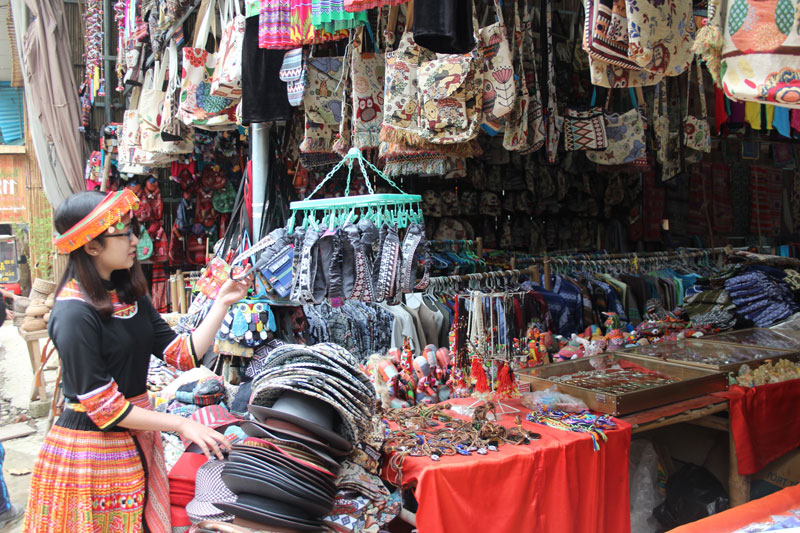
(HBO) - When the fog covering the town of Mai Chau gradually disappears, a small village with rustic houses on stilts show up, It is Pom Coong village imbued with characteristics of Thai ethnic people. Coming here, visitors can immerse themselves in the poetic natural scenery, enjoy traditional Thai ethnic food, grow rice and cook meals with ethnic people.

Tourists choose souvenirs in Pom Coong village, Mai Chau town, Mai Chau
district.
Pom Coong
means a village of hills lying on a big drum like the bronze one.
Currently,
Pom Coong is home to 70 households with 359 people and seven big families
living in harmony. Up to 89 percent of households are recognised as cultural
families. Pom Coong has been recognised as a cultural village for five
consecutive years. Local residents began providing homestay services in 1998, with
the first three families of Ha Thi Chung, Kha Van Vuong and Kha Van Hung. To
date, 15 households have engaged in this business. Up to 70 percent of visitors
are foreigners and the remaining are Vietnamese keen on Thai ethnic
characteristics. Pom Coong is attracting more and more tourists, earning locals
higher income. Last year, the village earned more than 2 billion VND from
tourism, or nearly 20 percent of the total revenue.
To lure
more visitors, local authorities and people always preserve special
characteristics of Thai ethnic culture, from stilt houses, traditional crafts
and costumes to folk dances. Thai ethnic people’s stilt houses are high, under
which, Thai young girls and women sit by the loom and weave brocade products.
Bows and
crossbows are also made available as souvenirs. When darkness falls down,
visitors could enjoy special music performances staged by local art troupes. In
the light of fire, flexible dances by beautiful Thai girls enchanted visitors.
The
village is well arranged and local residents abide by regulations of the
campaign "All people stand united to build cultural lifestyle in residential
areas”. There are not any social vices such as gambling, drug and prostitution.
Environment hygiene is ensured while garbage is classified and treated.
Chiho from
Japan said: "It is the first time I have visited
Vietnam.
Staying together with local family and joining in activities such as cycling,
rice growing, cooking ethnic food made me satisfied and impressed. Images of
Thai women next to the loom and pipe wine jar are unforgettable to me. After
returning home, I will introduce friends to Pom Coong village and return to the
village again”./.
The People’s Committee of Lac Son district held a ceremony on April 28 to receive the provincial relic certificate for the ancient rock carving site at Suoi Co stream, located in My Thanh commune.
A special music show titled "The country is in the fullness of joy” has been held at Hoa Binh Square in Hoa Binh city in celebration of the 50th anniversary of the liberation of the South and national reunification (April 30, 1975–2025).
The People's Committee of Lo Son commune, Tan Lac district, has organised the local annual traditional stream fishing festival on April 19 - 20.
As a land deeply intertwined with human history and Vietnam’s millennia-long journey of nation-building and defence, Hoa Binh is often revered for its epic tales and legends.
Residents of Hoa Binh boast a rich cultural identity, reflected in their unique language, traditional attire, customs, and folk melodies – described as "sweet as honey, clear as a mountain stream.”
Lac Son district’s Vu ban town held the 2025 Truong Kha temple festival on April 12–13 (the 15th–16th days of the third lunar month). Since its revival in 2019, the festival has been organised every three years, preserving valuable intangible heritage while meeting the community’s cultural and spiritual needs.



